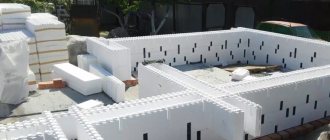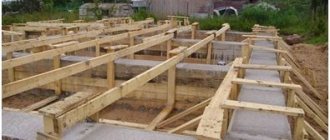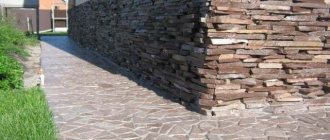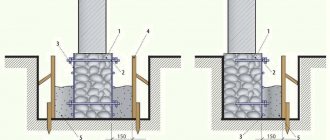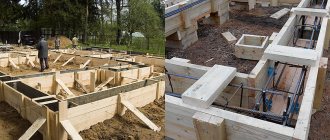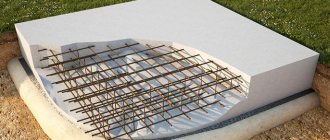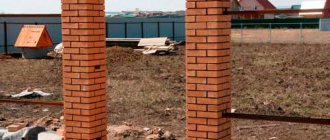Such a thing as round formwork refers to building elements of complex configuration. It is used for concrete and stone work. Sometimes it is used in the construction of wells. To make round formwork, you will need carpentry tools and carpentry skills.
Its production is carried out by carpenters of the fourth and fifth categories. It’s worth deciding in advance whether you can do everything yourself, or whether it’s better for you to hire a good specialist. In any case, you can try, and if you are stubborn enough and don't mind ruining the material, you can do it yourself.
Typically, foundation work, when it is necessary to make round formwork, is carried out under bay windows, under arched vaults or other complex building elements. People who want to make a house of such a complex configuration usually do not do it themselves, but hire other contractors.
Making formwork for a strip foundation
Due to the fact that the strip foundation has a number of features and differs from the classic options, formwork for it will also not be easy. In this situation, it is necessary to stock up on boards with a thickness of at least 50 mm. At the same time, you must understand that the height of the entire structure can be 2 meters or more.
At the same time, at the beginning of installation, it is always the guide boards that are taken. In fact, they will become the frame for the formwork and will help you start this work correctly. By the way, if you decide to build formwork more than 2 meters high, then instead of ordinary boards it is better to use panel materials. Take the highest quality ones and if you want the formwork to last as long as possible, then the width of the shield should be equal to the height.
Photo illustration: how to make formwork for a strip foundation
Every builder knows that there should be no gaps in the formwork. Nevertheless, such unpleasant errors regularly arise during the formwork construction process. That is why they should be sealed in advance. For this, ordinary tow is used, and if we are talking about really large cracks, then it is better to take slats for masking and put them on top.
During the construction process, various problems can arise and are often associated with the wrong choice of formwork type. Most people choose the removable option, but if your region has very cold winters, then this may not be the best solution. Also, before starting construction, pay attention to the foundation; the choice of materials for formwork will depend on it. And do not forget that it must be removed on time, because the strength of the structure directly depends on this.
Video instructions on how to make formwork for a strip foundation
How to make round formwork for a foundation
Making round formwork for the foundation
The round version of formwork has recently become very popular, even despite some difficulties in the process of its construction.
If you decide to take on this matter yourself, then you should immediately mark the place with special pegs. Then boards will be laid close to the stakes and the sides of the structure will be secured using ordinary nails. If the height is quite large, then you will also have to do installation work at the highest point.
To strengthen the structure, cladding boards are used. This is relevant in situations where the round formwork is filled with concrete on top. In principle, you can do without it, in this situation it all depends on you. Installation takes on average 2-3 days. During this time, it is quite possible to even make a plank covering and seal all the seams that spoil the appearance.
Types of circular formwork
Of course, a unique and original home of your own is wonderful. Especially when you can use unique architectural forms and non-trivial building elements. That’s why circular foundations are popular, the formwork for which can be made with your own hands in a matter of days.
But now there are two main options for formwork for such foundations: removable and non-removable. As a rule, removable formwork is used repeatedly; its role is to preserve the round shape of the future foundation and, when the concrete hardens, it is possible to dismantle the formwork and move it to another place.
Reusable formwork is often used in the construction of column bases; it is made from various materials, even plastic or wood.
Thus, the cost of constructing formwork largely depends on the type of foundation and building materials used.
How can you make a non-removable structure:
- Factory made polystyrene foam box. It is produced in various sizes and thicknesses, is flexible and all you need to do is assemble the finished structure right on site;
- The profiled sheet is of small thickness, which is easy to bend without breaking;
- Thin sheet steel.
Making removable formwork for the foundation
Making the classic version of formwork is quite simple, you just need to put in a little effort and be patient.
Initially, guide boards are taken and stakes are driven into the ground. Next we work with the foundation, it is necessary to place shields on one side. They must be placed vertically and done with braces, which will help achieve increased reliability. It is very important to respect the dimensions of the foundation, because then the shields will be installed on the other side of it.
The final stage of installation will be fastening the shields using special clamps. The interval between fasteners should be strictly 0.5-1 meter. This is the only way the formwork will not open during the pouring of concrete and will retain its strength. You can also install pegs or some kind of spacers outside for additional fastening. In the end, you will have removable formwork.
Removable formwork for foundation
Construction of round shapes
- Selection of building materials. Here you should first make calculations about what material will be used, as well as determine its advantages and disadvantages.
- Development of a project for the future foundation.
- Digging a pit. The diameter of the pit should be larger by the thickness of the formwork, taking into account the waterproofing and thermal insulation layers, as well as for the convenience of working inside the pit.
- Forming a sand cushion and installing a frame on the sides. In some cases, the use of wooden beams that are dug into the ground justifies itself. Then they need to be tied with wire around the outer perimeter, and a fixing wire should be placed on top. In such cases, there is no deformation of the structure.
- In the case of using permanent wooden formwork, protection from groundwater must be made on top of the outer surface. For such purposes, roofing felt is excellent; it is fixed to the beams with clamps and glue, and the seams are filled with resin. Thermal insulation made of polystyrene foam is already installed on top.
If plastic and polymer materials are used for the construction of round formwork, then the technology is similar, only here special factory clamps are used. It is clear that plastic will be a little more expensive than a wooden structure, but it lasts longer and is thinner. In some cases, this option justifies itself more than a tree.
How to make formwork from boards
At the moment, wood is the most popular choice for formwork construction. High-quality boards cannot replace any other materials. Above we have already described how to make wooden formwork and the key aspects of working with boards.
Now it’s worth noting why it’s worth choosing such natural material:
- If the structure consists entirely of wood, then it is much easier to adjust;
- It is as simple and convenient to erect as possible, because all you need is a tape measure and a hammer.
Board formwork
But against the backdrop of quite loud advantages, there are also minor disadvantages:
- It is difficult to make round formwork from wood;
- If you pour a lot of mortar inside the structure, you will have to think about supports;
- In the process of leveling the structure, you may encounter the problem that the board is nailed incorrectly and this flaw is very difficult to correct.
In principle, one could also say that wooden formwork will cost you more than any other, but the cost of the material is completely justified. This is exactly the case when it is better to overpay in advance so as not to encounter problems in the future.
Video: DIY wooden formwork
Types of circular formwork
There are quite a lot of materials on how to make a round foundation. At each stage, the work contractor will need new equipment and tools. And the first of them will be formwork. It is divided into several types depending on the material used in the work.
First of all, formwork is divided into removable and non-removable. The first option is used many times. It is made from high-quality materials and after the concrete mixture has hardened, it is dismantled for subsequent use. Permanent formwork is immersed in concrete and remains there forever.
For the construction of permanent formwork, a polystyrene foam box, thin profiled sheet, or thin sheet steel are used. It is easy to make formwork of any shape from these materials, which occupy a minimal area.
Expanded polystyrene formwork has many practical advantages, one of which is thermal insulation properties. Thanks to this, laying such permanent formwork provides the house with additional heating.
Permanent formwork made of metal sheets is quickly erected and has excellent technical characteristics. When arranging the base, sheets of minimal thickness are used. metal conducts heat poorly, but reliably protects against moisture penetration.
- The use of metal for the construction of round formwork guarantees high speed of work, at low cost and high quality of work performed. Construction timber that has undergone primary processing, as well as edged boards and plywood are used as building materials. Installation on site takes place vertically and quickly achieves results.
- The main advantage of the wooden type of round formwork is the low cost of materials. They can be produced not only on a sawmill, but also directly on the site using simple tools, you can create formwork for subsequent pouring of the concrete mixture of the base.
- Recently, builders are increasingly resorting to the use of removable plastic formwork. This type of material varies significantly in price depending on the quality of the plastic, wall thickness and fragility of the structure. The main and practically valuable feature of the plastic form is that they are almost not destroyed upon contact with aggressive reagents. This factor makes it possible to use plastic formwork when arranging a round foundation and leave it completely in the ground.
The special formwork used to build a round foundation can vary in thickness and the presence of fasteners, in height and strength, and in many other parameters. This diversity opens up opportunities for a wide selection of designs in accordance with the needs of a specific customer.
The direct construction of round foundations consists of several main stages, each of which plays an important role.
- Selection of optimal building materials. This stage is decisive during construction and consists of a deep analysis of pre-design data, careful work of the designer and numerous calculations. Here it is important to determine the advantages and disadvantages of each option in refraction to a specific object.
- After completing the preparatory calculations, the architect begins to select the foundation design and its calculations.
- After approval of the design documentation, they begin to dig a pit in accordance with the standards.
- Arrangement of the cushion in the pit and placement of the formwork frame.
- Pouring the foundation within the established limits.
In other words, the process of constructing a round base is completely consistent with the construction of a conventional foundation. The peculiarity is that the work requires attention to the geometric accuracy and reliability of the structure.
How to make formwork for the foundation of a bathhouse
The procedure is similar to installing formwork under the foundation. However, it is worth considering that you will have to work with a bathhouse and this has its own characteristics.
First, stakes are driven in outside the structure. It must be remembered that this is done strictly vertically and best along the cords. Your task is to maintain maximum accuracy, otherwise you will have to redo absolutely everything. In situations where builders are not careful about this task, the originally planned size of the structure often changes. That's why be precise from the very beginning.
Formwork for the foundation of a bathhouse: start of work
Once the stakes have appeared in the ground, you can attach boards to them. You should start from top to bottom. Installing at the top of the board is quite easy and won't pose much of a problem. When it comes to the lower ones, which are located right next to the foundation, you will have to take a pry bar and press the boards tightly against each other.
If all the boards are securely installed, then you can do whatever you want with them. Often at this stage the boards are trimmed to achieve aesthetic appeal.
Finally, you will need to think about the strength of the entire structure. First, special supports are placed under each stake, then under the upper planks. You need to understand that the next step will be pouring concrete and you need to do everything possible to ensure that the structure does not simply fall apart. Nevertheless, the upper strips should be fastened as carefully as possible.
Video: Homemade formwork for the foundation of a bathhouse
Next, you will have to install a reinforcing frame that will affect them. While pouring the concrete itself, inspect the places where the cushion comes into contact with the boards. There may be small gaps between the ground and the structure. It is necessary to get rid of them and the most suitable option would be to use soil. Fill the cracks and do your best to ensure that there are no gaps at all. At this point, the construction of the formwork for the bathhouse can be considered complete.
Formwork for the foundation of a bathhouse - the result
Design and manufacturing technology of formwork for columnar foundations
This formwork is usually made from boards, so you need to take them first. You can install it in any place you need.
The design will be a rectangle with a fixed internal size and height, which you can choose yourself. Fastening the boards can be easily done using ordinary self-tapping screws. They must be driven directly into the end of the board. As soon as this stage is completed, it would be a good idea to check the verticals and horizontals of the structure.
Next, a columnar support is made, where each column is lined up with cords that you will have to tighten in advance. Now you can dig a hole and install the finished rectangle in it. Outwardly, it very much resembles a box, which is why most builders call it that. When the structure is in the place you want, you will have to lightly fill it with soil from the outside. In fact, this procedure is identical to that described for the construction of a strip foundation. The installation technologies for both formwork options are almost identical.
Manufacturing of formwork for a columnar foundation
Once the installation is complete, you can remove all castoffs. Now you will only need them to control the zero level in the bathhouse. In principle, 1-2 cast-offs will be enough to solve this problem. As you can see, there is nothing complicated in constructing formwork of various types, so you can even try it at home!
October 31, 2021 Author: Vladimir Bakaev
